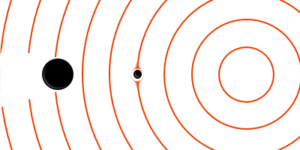What is Sound?
A drummer bangs on a bass drum. Sam, standing nearby, hears BOOM! How does banging on the drum turn into the sound BOOM? Sounds are vibrations, and the drum-head’s back-and-forth vibrations create pressure waves in the air that set Sam’s eardrums, just inside his ears, into vibration. The magic of sound happens deeper inside Sam’s ears in a hollow tube-like structure called the inner ear or cochlea. Imagine that you’ve shrunk yourself so small that you can look into this tube. When you peek inside, you see thousands of tiny hairs lined up in rows. Suddenly, the drummer bangs the drum! You feel the vibrations, and then you see something spectacular – the hairs are moving back and forth in time with the vibrations, and every movement is creating electrical signals! These signals are sent down the auditory nerve towards the brain and a fraction of a second later, when they reach the hearing areas in the brain, Sam hears BOOM! What makes some vibrations create a drum’s low-pitched BOOM and others create a bird’s high-pitched tweet? Slow vibrations create low pitches and faster vibrations create high pitches, so the hairs vibrate more slowly for BOOM and faster for tweet. But sound is more than BOOM and tweet. You create sounds when talking with friends or playing music. Music is really amazing, because when the tiny hairs vibrate back and forth to music, electricity reaches the brain’s hearing areas, plus other brain areas that make you move and that make you feel emotions like happy or sad. So sounds are vibrations that make you hear, and might also make you feel like tapping your feet, dancing, crying, or even jumping for joy. Pretty amazing, what tiny hairs vibrating inside the ear can do!
What is Acoustics?
Acoustics is the science of sound and someone who studies acoustics is called an acoustician.
There are many kinds of sound and many ways that sound affects our lives. For example, we use sound to talk and sound is important for designing musical instruments, concert halls, surround sound stereo and hearing aids. Sound can also be used to find oil and gas, to study earthquakes and climate change, and to make sure that the baby in a mother’s womb is healthy. There are the sounds humans can hear, but there are also sounds that only some animals can hear, like a dog whistle.
There are a lot of different acoustics fields of study. If you study acoustics, you might study the production, control, transmission, reception, or effects of sound on people, animals or even objects.
The World Through Sound 
Click here to learn about some of the most fundamental concepts in acoustics. Understanding these concepts can help you understand larger concepts in science. These articles are part physics lesson and part philosophy, and are meant to be useful for scientists and non-scientists alike. If you are a non-scientist with little exposure to acoustics, you will learn what basic concepts such as sound speed and frequency really mean beyond the mathematical formulas and formal definitions. For seasoned acousticians this series will offer new perspectives that can help you to better explain acoustics to others.
What do acousticians do?
Lots of people study sound so there are many different kinds of acousticians! Here are some examples:
- An acoustical engineer can design transducers such as microphones, earphones, and loudspeakers.
- A bioacoustician might research bird populations to determine whether or not man-made noise changes their behavior.
- An audiologist can diagnose hearing impairments.
- A hearing scientist can conduct research about hearing loss prevention.
- An architectural acoustician could design an opera house so that people in the audience can enjoy the music to the fullest.
- A noise specialist could do work to reduce noise caused by airplanes, cars and trains.
- An underwater acoustician might design sophisticated sonar hardware to explore the ocean floor.
- A biomedical acoustician could develop medical equipment to destroy kidney stones.
Meet Acousticians
Acousticians include engineers, physicists, speech and hearing scientists, architects, linguists, biologists, psychologists, mathematicians, oceanographers, computer scientists, and musicians. Read different career profiles in acoustics.
Fields of Acoustics
Since there are many different areas of study and practice within acoustics we have condensed materials into 6 main content areas.

